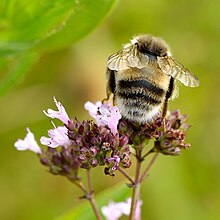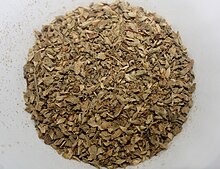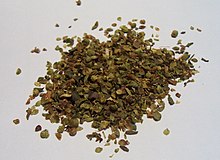oregano
| oregano | ||||||||||||
|---|---|---|---|---|---|---|---|---|---|---|---|---|

Real dost ( Origanum vulgare ) |
||||||||||||
| Systematics | ||||||||||||
|
||||||||||||
| Scientific name | ||||||||||||
| Origanum vulgare | ||||||||||||
| L. |
Oregano [ oʁeːganoː ] or Real Dost ( Origanum vulgare ) is a species in the genus Dost from the family of the Labiatae (Lamiaceae). Common names are, for example, Dorst , Dost , Gemeiner Dost , Gewöhnlicher Dost , Wohlgemut or Wilder Marjoram . It is used as spice - and medicinal plant uses.
description
Appearance
The oregano is a perennial herbaceous plant that reaches heights of 20 to 70 centimeters. Their distinctive herbal fragrance and taste are characteristic. From an often woody rhizome (colloquially “root stock”) the upright, square, branched stalk sprouts from the ground up . Like the mostly reddish overflowing branches, this has a slight hairiness.
leaf
The opposite constantly disposed on the stem leaves are divided into petiole and leaf blade. The petiole is 2 to 7 millimeters long. The simple leaf blade is usually 25 to 40 (10 to 45) millimeters long and about 15 (4 to 30) millimeters wide and is oblong and ovoid and usually tapering to a point. On the underside of the leaf one can notice a glandular puncture. The leaf margin can be slightly serrated or smooth. Some specimens also develop fine hairs on the leaf margins.
Inflorescence and flower
The partial inflorescences grouped together in terminal or lateral, densely packed, spherical false panicles develop numerous flowers between July and September.
The hermaphrodite flower is zygomorphic and five-fold with a double flower envelope . The five dark green, about 3 millimeters long sepals are fused together. The five calyx teeth are designed the same and develop - like the bracts - usually a slight purple color. The calyx is significantly shorter than the corolla tube. The five pink-violet, rarely whitish petals are fused into a bell-shaped, 4 to 6 millimeter long corolla tube that ends with two lips. The lower lip is three-lobed. The upright upper lip is edged and consists of two petals. Of the four stamens, two are shorter and two are longer; they sit on the corolla tube. The two longer stamens protrude from the corolla tube, the two shorter ones usually end just below the upper lip. Two carpels are to one divided by a false partition walls into four compartments Upper permanent ovary grown. The ovary turns into a long stylus that ends in two small scars.
fruit

The Klaus fruit disintegrates into an approximately 1 millimeter long, oval nut with a brown and smooth surface.
Chromosome number
The number of chromosomes is 2n = 30 or 32.
ecology
Oregano is a hemicryptophyte of the stem plant type or a chamaephyte . The vegetative reproduction is ensured by underground runners . The leaves are dotted on the underside by oil containers. The essential oils give the plant a strong aromatic smell and also serve as protection against perspiration.
From an ecological point of view, it is "real lip flowers". In addition to relatively large hermaphroditic flowers, small female flowers and also plants on which only female flowers develop. The species is thus gynomonözisch or gynodiözisch.
The oregano offers nectar that can contain up to 76% sugar. A layer of sap made of hair forms a protection. The flowers are particularly popular with honey bees . There are also numerous species of butterflies, such as the great ox-eye , the chessboard butterfly or the little meadow bird and hoverflies . The maximum flower visit takes place at 1 p.m. Pollination takes place via the insect's back. The corolla is thrown off after pollination. Self-pollination does not usually occur.
The Klausen fruits open in drought. It spreads as a wind spreader and as a self-spreader. The diaspores are spread out by the wind as balloon fliers. It was also observed that earthworms prefer to eat the fruit.
Fruit ripening is from October to November.
Occurrence
Originally native to the Mediterranean region, the plant species is grown and used worldwide in warm and temperate areas. Natural occurrences are found in almost all of Europe. Oregano prefers warm locations on calcareous subsoil . It mostly inhabits dry and open forests, such as oak and pine forests or snow heather and pine forests. Bushes at the edges of paths and forests, sunny slopes and hedges, as well as poor and dry grasslands, are among its regular habitats. In Central Europe it is a character species of the order Origanetalia vulgaris.
Systematics
The first publication of Origanum vulgare was done in 1753 by Carl Linnaeus in Species Plantarum , 2, S. 590. There are many synonyms .
Of Origanum vulgare L. about six subspecies are known:
- Algerian oregano ( Origanum vulgare subsp. Glandulosum (Desf.) Ietsw. , Syn . : Origanum glandulosum Desf. ): It occurs from northern Algeria to Tunisia.
- Russian oregano ( Origanum vulgare subsp. Gracile (K.Koch) Ietsw. , Syn .: Origanum glaucum Rech.f. & Edelb. , Origanum gracile K.Koch , Origanum kopetdaghense Boriss. , Origanum tyttanthum Gontsch. ): It comes from the Turkey to Central Asia.
- Origanum syriacum L. (Syn .: Origanum maru L. )
- Greek oregano ( Origanum vulgare subsp. Hirtum (Link) Ietsw. , Syn .: Majorana neglecta . (Vogel) Walp , Origanum heracleoticum Benth. , Origanum hirtum Link , Origanum hirtum var. Illyricum (Scheele) Nyman , Origanum hirtum var. Latifolium Nyman , Origanum hirtum var. Neglectum (Vogel) Nyman , Origanum illyricum Scheele , Origanum latifolium Scheele , Origanum megastachyum Link , Origanum neglectum Vogel , Origanum smyrnaeum Sm. , Origanum vulgare var. Megastachyum (Link) WDJKoch ): It comes from Southeastern Turkey in front.
- Origanum vulgare subsp. virens (Hoffmanns. & Link) Ietsw. (Syn .: Origanum macrostachyum Hoffmanns. & Link , Origanum virens Hoffmanns. & Link , Origanum virescens Poir. ): It occurs in Macaronesia and in the western Mediterranean.
- Origanum vulgare subsp. viridulum (Martrin-Donos) Nyman (Syn .: Origanum angustifolium K. Koch , Origanum gussonei Tineo ex Lojac. , Origanum heracleoticum L. , Origanum hirtum var. parviflorum (d'Urv.) Nyman , Origanum hirtum subsp. sardoum (Moris) Nyman , Origanum hirtum var. Sardoum Moris , Origanum humile Mill. , Origanum minus Garsault , Origanum normal D.Don , Origanum oblongatum link , Origanum parviflorum d'Urv. , Origanum pruinosum K.Koch , Origanum semiglaucum Boiss. & Reut. ex Briq . , Origanum strobilaceum Mobayen & Gahraman , Origanum viride (Boiss.) Halácsy , Origanum viridulum Martrin-Donos , Origanum vulgare var. semiglaucum Boiss. ex Briq. , Origanum vulgare var. thyrsiflorum Rchb. , Origanum vulgare var. viride Boiss. , Origanum vulgare var. viridulum (Martrin-Donos) Briq. , Origanum wallichianum Benth. ex Wall. ): It occurs from southern Europe to the Himalayas. The number of chromosomes is 2n = 30.
- Origanum vulgare L. subsp. vulgare (Syn .: Mentha formosana (C.Marquand) SSYing , Micromeria formosana C.Marquand , Origanum albiflorum K.Koch , Origanum americanum Raf. , Origanum anglicum Hill , Origanum barcense Simonk. , Origanum capitatum Willd. ex Benth. , Origanum creticum L. , Origanum decipiens Wallr. ex Benth. , Origanum dilatatum Klokov , Origanum elegans dairymen , Origanum heracleoticum Rchb. , Origanum hirtum f. albiflorum Hausskn. , Origanum latifolium Mill. , Origanum laxiflorum Royle ex Benth. , Origanum loureiroi Kostel. , Origanum majus Garsault , Origanum megastachyum var. hirtum Schur , Origanum micranthum Colla , Origanum nutans Willd. ex Benth. , Origanum officinale Güldenst. , Origanum orientale Mill. , Origanum puberulum (Beck) Klokov , Origanum purpurescens Gilib. , Origanum serpylliforme fish. & Camey . , stoloniferum Origanum Better ex Rchb. , Origanum thymiflorum Rchb. , Origanum ulcers Willd. ex Benth. , Origanum vulgare var. albidum Bellynck , Origanum vulgare var. albiflorum Lej. , Origanum vulgare var. Album Fraas , Origanum vulgare f. carneum Beckh. , Origanum vulgare subsp. creticum (L.) Nyman , Origanum vulgare var. creticum (L.) Briq. , Origanum vulgare var. Glabrescens Beck , Origanum vulgare var. Heracleoticum Nyman , Origanum vulgare var. Hirtum (Schur) Soó , Origanum vulgare var. Humile (Pers.) Lej. , Origanum vulgare subsp. humile pers. , Origanum vulgare var. Macrostachyum (Hoffmanns. & Link) bread. , Origanum vulgare var. Pallescens Tinant , Origanum vulgare f. pallidum Beckh. , Origanum vulgare var. Prismaticum Gaudin , Origanum vulgare var. Puberulum Beck , Origanum vulgare var. Purpurascens Briq. , Origanum vulgare var. Spiculigerum Briq. , Origanum vulgare var. Thymiflorum (Rchb.) Nyman , Origanum watsonii A.Schlag. ex JASchmidt , Oroga heracleotica Raf. ): It occurs from Europe to China.
Origin of name
The name “Orégano” was borrowed into the German language through the Italian “origano” and comes (via Latin origanum ) from ancient Greek ( τὸ ὀρίγανον , also ἡ ὀρίγανος ). The etymology is unclear; it is considered a foreign word of unknown origin in Greek. The name is folk etymologically with ὄρος ( óros ) "mountain, mountain" and γάνος ( gános ) "shine, shining; Refreshment ”.
ingredients
Essential oils such as thymol and carvacrol and p-cymene , tannins and bitter substances . The vitamin C content of the fresh drug is 0.2672 g per 100 g fresh weight .

use
Oregano in the kitchen
Oregano has been used as a condiment for at least 300 to 400 years. Apart from the not entirely clear Roman sources, only one Basel recipe from the 17th century can be cited in which oregano is mentioned as an ingredient in pancakes . Otherwise, botanical books, even at the beginning of the 20th century, only leave out that oregano is a medicinal and magic plant and that wool can be dyed with its red dye.
Oregano plays a minor role as a spice in German cuisine. It is a very important spice in Italian, Greek and Spanish cuisine, but it is also widely used throughout the rest of the Mediterranean. Oregano goes well with omelets , Italian sauces, tomato dishes, lamb or vegetable casseroles.
In Tex-Mex cuisine , oregano is often used with cumin , chillies , garlic and onions . Among other things, it is an important component of Chili con Carne . Often, however, it is replaced by Mexican oregano ( Lippia graveolens ), a Central American herb. This is only distantly related to the actual oregano, but has a similar but stronger taste. The real Greek oregano ( Origanum vulgare spp. Hirtum ) offers the most intense taste , whereas marjoram ( Origanum majorana ) tastes less intense. Also Turkish Oregano ( Origanum onites ) is used.
Culture and harvest
Oregano thrives best in dry and sunny locations. It is hardy in temperate climates . For harvesting, whole stems are cut off a hand's breadth above the ground and hung in a dark room to dry. After drying, the leaves can be stripped from the stem and kept dry.
Oregano in herbal medicine
Dost was already known to the Greeks as a ("warming") remedy. Dioscurides reports about him in his work De materia medica from the 1st century AD. Hippocrates of Kos used this plant to accelerate birth and to heal hemorrhoids .
In modern herbal medicine, the common Dost is rarely used as a component of a tea mixture against cramp-like stomach and intestinal problems.
Oregano essential oil
Oregano oil is considered effective against bacteria in aromatherapy due to its very high phenol content . As it can irritate the skin, it should only be used internally and diluted with a carrier oil (e.g. sunflower oil). A single dose of 50 mg (two drops) is given up to ten times a day.
A positive effect on digestive problems and diseases of the upper respiratory tract could also be proven . The ingredient carvacrol has an anti-inflammatory effect.
Oregano in superstition
In the Middle Ages, dost was regarded as an important witch-repellent plant and was supposed to protect against the devil. They were held under the witches' noses in order to free them from the devil. Dost is said to be the herb that makes grief go away, rebuilds lost courage and makes people happy. For this reason, the plant also bears the name Wohlgemut.
Oregano or Dost was placed in the bridal shoe as protection against evil forces and integrated into the bridal bouquet. In the form of incense, dost was already used in antiquity as a demon repellent. If a child did not speak for a long time, they would give them a spoonful of oregano water. Against epilepsy , the patient was allowed to smell Dost crushed with his fingers.
See also
literature
- Xi-wen Li, Ian C. Hedge: Lamiaceae. Origanum vulgare , p. 233 - online with the same text as the printed work . In: Wu Zheng-yi, Peter H. Raven (Ed.): Flora of China. Volume 17: Verbenaceae through Solanaceae. Science Press and Missouri Botanical Garden Press, Beijing and St. Louis 1994, ISBN 0-915279-24-X . (Section Description; English)
- Pronatura: nectar plants. (PDF file; 5 kB; Swiss)
- Eckehart J. Jäger, Klaus Werner (Ed.): Excursion flora from Germany. Founded by Werner Rothmaler. 18th, edited edition. Volume 2. Vascular plants: base volume . Spektrum, Heidelberg et al. 2002, ISBN 3-8274-1359-1 .
- Ruprecht Düll , Herfried Kutzelnigg : Pocket dictionary of plants in Germany. A botanical-ecological excursion companion to the most important species . 6th, completely revised edition. Quelle & Meyer, Wiebelsheim 2005, ISBN 3-494-01397-7 .
- Ruprecht Düll , Herfried Kutzelnigg : Pocket dictionary of plants in Germany and neighboring countries. The most common Central European species in portrait . 7th, corrected and enlarged edition. Quelle & Meyer, Wiebelsheim 2011, ISBN 978-3-494-01424-1 .
Web links
- Origanum vulgare at Plants For A Future
- Oregano . In: BiolFlor, the database of biological-ecological characteristics of the flora of Germany.
- Origanum vulgare L. In: Info Flora , the national data and information center for Swiss flora . Retrieved February 24, 2016.
- Distribution in the northern hemisphere
- Thomas Meyer: Data sheet with identification key and photos at Flora-de: Flora von Deutschland (old name of the website: Flowers in Swabia ).
Individual evidence
- ↑ Origanum vulgare L., Ordinary Dost. In: FloraWeb.de.
- ↑ a b Erich Oberdorfer : Plant-sociological excursion flora for Germany and neighboring areas . With the collaboration of Angelika Schwabe and Theo Müller. 8th, heavily revised and expanded edition. Eugen Ulmer, Stuttgart (Hohenheim) 2001, ISBN 3-8001-3131-5 , pp. 812-813 .
- ↑ a b Origanum vulgare in the Germplasm Resources Information Network (GRIN), USDA , ARS , National Genetic Resources Program. National Germplasm Resources Laboratory, Beltsville, Maryland.
- ↑ a b c d e f Rafaël Govaerts (Ed.): Origanum vulgare. In: World Checklist of Selected Plant Families (WCSP) - The Board of Trustees of the Royal Botanic Gardens, Kew . Retrieved January 11, 2018.
- ^ Encyclopedia of Life .
- ↑ Origanum maru L. in: United States Department of Agriculture .
- ↑ Helmut Genaust: Etymological dictionary of botanical plant names. Birkhäuser, Basel / Stuttgart 1976, ISBN 3-7643-0755-2 , p. 272.
- ↑ Pedacii Dioscoridis Anazarbaei herb book [...]. Translated into German by Johannes Danzius, Frankfurt am Main (Petrus Uffenbach) 1610; Reprint Grünwald near Munich 1964, p. 168 ("Wolgemut - Origanos, Cunila [...], Dost [...] has the strength to warm up [...]").
- ↑ Dioscurides. ( Memento of the original from September 24, 2015 in the Internet Archive ) Info: The archive link was inserted automatically and has not yet been checked. Please check the original and archive link according to the instructions and then remove this notice. here page 175 (PDF; 4.46 MB)






